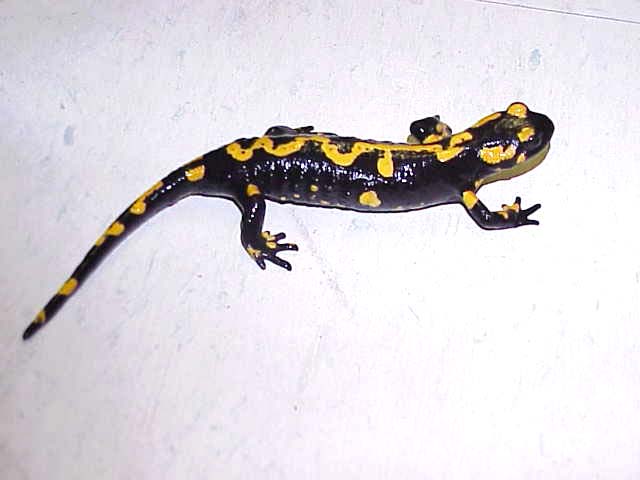Salamander - Fire
European Fire Salamander Scientific Name: Salamandra salamandra
Sat, 12th July, 2025 - 5:53 am GMT
Sponsor Ads:

Alternative Name
European Fire Salamander Scientific Name: Salamandra salamandraBasic Info
At birth, the aquatic Fire Salamander larvae are 1 inch in length. The larvae will metamorphose and measure 1.5 to 2 inches after only two or three months. The adult, terrestrial, Fire Salamander typically reaches a length of 6 to 8 inches and can grow to nearly 12 inches, making them the largest members of the Salamandridae. The female Fire Salamanders generally grow larger than the males. The legs of this salamander are short and their body length is longer than that of their tail. The Fire Salamander has a long life span, often living up to 20 years in the wild.
Health
Unlike many amphibians the Fire Salamander does not survive in extremely warm temperatures. For this reason, they require a relatively cool climate in the range of 60-70 degrees Fahrenheit. In their vivarium, be sure to include a land area with peat, potting soil, or sphagnum moss as substrate. For water, include a small container in the vivarium, making sure that there are rocks or branches, which the Salamander can use as a way to get out of the water. It is very important that the Salamanders have enough individual space. If you notice them stacking onto one another, this means it is time for a bigger home, since stacking can lead to skin infections. Breeding In captivity, breeding of Fire Salamanders is induced by temperature changes. After courtship and fertilization, the eggs will gestate within the female for a time span of anywhere between six months to a year. Females ready to give birth should be moved into a birthing container with both water and dry land. Water should be either aged tap or spring. The very round female gives birth in batches, and this process can take days. As the larvae are born, they should be moved to an aquarium also filled with spring or aged tap water. An under gravel or sponge filter should be used in order to keep the tank clean. Other large filters can be too much for the small larvae - either sucking them in or tossing them about. Aquatic plants in the water will help to provide oxygen as well as hiding places for the larvae. Daphnia, brine shrimp, and tubifex worms can be used as food for the larvae almost immediately. Warmer water encourages growth, and as soon as you notice adult coloration, the water level should be lowered and land offered to the larvae so they can exit the water and keep from drowning.Habitat
N/ABehavior
Anyone looking for a brightly colored, unique, and long living pet should consider the Fire Salamander. Though the Fire Salamander is a little bit shy, they can be handled as long as you remember to wash your hands after you are done. The Fire Salamander can be housed with other Fire Salamanders but interaction with other pets in your household should never happen. The Fire Salamander has poison glands on its skin,so if your other pets make contact with their skin, it could be very toxic or even deadly to them. If you have the space for a 10-gallon vivarium in your household and are able to keep an animal in temperatures of a 60-70 degrees Fahrenheit range, then the Fire Salamander might make a very good and colorful addition as a pet. The Fire Salamander has a black body typically covered with yellow or orange spots. As larvae, they are colored in a mixture of brown and tan with an occasional fleck of gold. They attain their adult colors right before leaving the water for their terrestrial life. Due to the large number of Fire Salamander sub-species, it is also not unusual to see the color pattern in large splotches or bands. The underside of this Salamander is a dark gray with fewer spots.Origin
Europe, Middle East, and north AfricaHistory
The Fire Salamander can be found in central and southern Europe as well as northern Africa and the Middle East. The Fire Salamanders enjoy heavily wooded areas in the wild where it is easy enough for them to find shelter and adequate moisture under fallen trees and rocks. The Fire Salamander attained its name from the legend of their ability to survive in fire.Common Foods
feeds primarily on insects, earthworms, small rodents, small animals.Sponsor Ads:
"Testing can prove the presence of bugs, but not their absence." -- Dykstra
Salamander - Fire
Coded by: BGID® | ALL RIGHTS RESERVED Copyright © 2000-2025
Disclaimer | Privacy | Report Errors / Contact | Credits
















